Asthma

Asthma
Asthma: Unraveling the Respiratory Conundrum
Asthma is a chronic respiratory condition characterized by inflammation and narrowing of the airways, resulting in recurrent episodes of wheezing, breathlessness, chest tightness, and coughing. This condition affects people of all ages and can significantly impact their daily lives. Understanding asthma’s symptoms, types, and causes is crucial for effective management and improved quality of life for individuals dealing with this respiratory challenge.
Symptoms of Asthma:
- Wheezing: A hallmark symptom, wheezing manifests as a high-pitched whistling sound during breathing. It is a result of air struggling to pass through narrowed airways.
- Breathlessness: Asthma can cause a feeling of breathlessness or shortness of breath, especially during physical activities or exposure to triggers.
- Chest Tightness: Individuals with asthma often describe a sensation of tightness or pressure in the chest, contributing to discomfort.
- Coughing: Persistent coughing, particularly at night or early morning, is common in asthma. It may be the only symptom in some cases.
These symptoms can vary in severity and frequency, and not all individuals with asthma experience the same set of symptoms. Asthma symptoms may also worsen in response to triggers, which can include allergens, irritants, respiratory infections, or physical exertion.
Types of Asthma:
- Allergic (Extrinsic) Asthma:
– Triggered by exposure to allergens such as pollen, pet dander, mold spores, or dust mites.
– Allergic reactions play a significant role in causing airway inflammation and bronchoconstriction.
- Non-Allergic (Intrinsic) Asthma:
– Not linked to specific allergens but can be triggered by factors like stress, exercise, cold air, or respiratory infections.
– Non-allergic inflammation contributes to airway narrowing and asthma symptoms.
- Exercise-Induced Bronchoconstriction (EIB):
– Some individuals experience asthma symptoms primarily during or after physical activity.
– Exercise triggers temporary narrowing of the airways, leading to symptoms like wheezing and shortness of breath.
- Occupational Asthma:
– Exposure to workplace irritants or allergens can lead to the development of asthma.
– Common triggers include chemicals, dust, or fumes present in certain occupational settings.
- Childhood-Onset Asthma:
– Asthma that begins in childhood and may persist into adulthood.
– Often associated with allergies and family history of asthma.
- Adult-Onset Asthma:
– Asthma that develops in adulthood, sometimes without a clear allergic component.
– Can be triggered by respiratory infections, exposure to irritants, or hormonal changes.
Causes of Asthma:
- Genetic Factors:
– Family history plays a role in asthma susceptibility. Individuals with parents or siblings with asthma may have a higher risk.
- Allergies:
– Exposure to allergens, such as pollen, pet dander, mold, or dust mites, can trigger allergic asthma.
- Environmental Factors:
– Air pollution, exposure to tobacco smoke, and other environmental pollutants can contribute to asthma development and exacerbation.
- Respiratory Infections:
– Viral infections, especially during early childhood, can increase the likelihood of developing asthma.
- Occupational Exposures:
– Workplace exposure to irritants or allergens can lead to occupational asthma.
- Physical Activity:
– Exercise-induced bronchoconstriction can be a trigger, especially in individuals with pre-existing asthma.
- Tobacco Smoke:
– Exposure to tobacco smoke, either actively or passively, is a significant risk factor for asthma development and worsening symptoms.
- Stress:
– Emotional stress can contribute to asthma symptoms, although the exact mechanisms are not fully understood.
Conclusion:
Asthma is a complex respiratory condition influenced by a combination of genetic, environmental, and lifestyle factors. Recognizing the diverse symptoms and understanding the various types of asthma can guide healthcare professionals in tailoring effective management strategies. With proper diagnosis, personalized treatment plans, and avoidance of triggers, individuals with asthma can lead fulfilling lives while effectively managing their respiratory health. If someone experiences symptoms suggestive of asthma, consulting with a healthcare provider is essential for accurate diagnosis and appropriate management.
Bronchitis
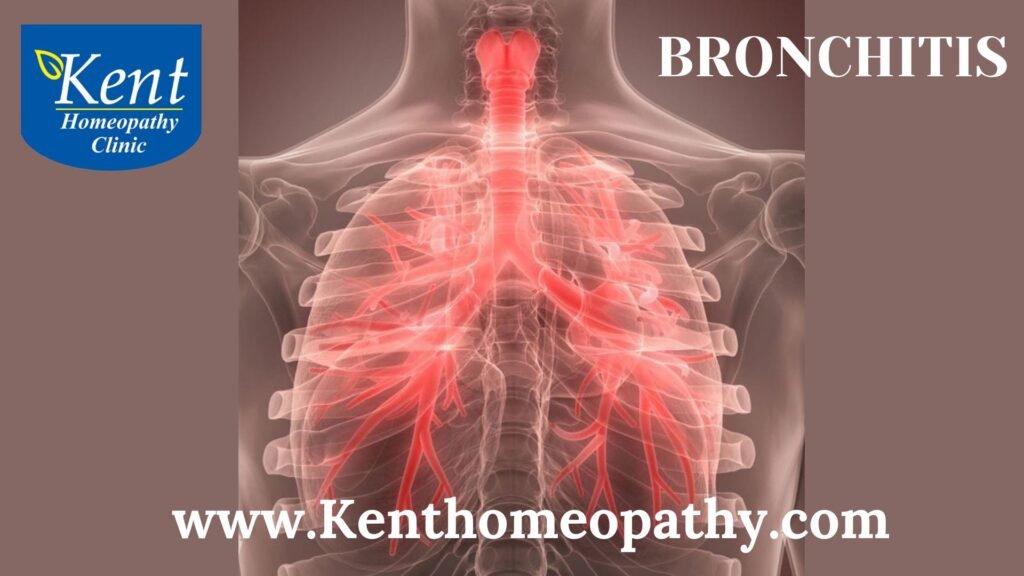
Bronchitis
Bronchitis is a respiratory condition characterized by inflammation of the bronchial tubes, which are the air passages that carry air to the lungs. This inflammation can lead to increased mucus production, narrowing of the airways, and various respiratory symptoms.
There are two main types of bronchitis: acute bronchitis and chronic bronchitis.
Acute Bronchitis:
Acute bronchitis is a short-term inflammation of the bronchial tubes, often caused by viral infections. Common viruses include the influenza virus or the common cold virus. Occasionally, bacteria may also be responsible. The hallmark symptoms of acute bronchitis include coughing, chest discomfort, and production of thick or discolored mucus. Other symptoms may include fatigue, fever, and shortness of breath.
Chronic Bronchitis:
Chronic bronchitis is a long-term condition characterized by persistent inflammation of the bronchial tubes. It is a type of chronic obstructive pulmonary disease (COPD). Chronic bronchitis is typically caused by long-term exposure to irritants such as cigarette smoke, air pollution, or occupational dust and chemicals. Unlike acute bronchitis, chronic bronchitis persists for at least three months in two consecutive years. Symptoms include a chronic cough, increased production of mucus, wheezing, and shortness of breath.
Common Symptoms:
- Cough: Persistent coughing is a primary symptom, which may produce clear, yellow, green, or even blood-tinged mucus.
- Chest Discomfort: Patients often experience a feeling of tightness or discomfort in the chest.
- Shortness of Breath: This symptom may range from mild to severe, especially during physical activities
- Wheezing: Some individuals may develop a whistling or squeaky sound when breathing due to narrowed airways.
- Fatigue: Chronic bronchitis can lead to fatigue as the body works harder to breathe.
Causes:
- Viral Infections: Acute bronchitis is commonly caused by viral infections, including influenza, rhinovirus, or respiratory syncytial virus.
- Bacterial Infections: Bacterial infections, though less common, can also contribute to bronchitis. For example, Mycoplasma pneumoniae is a bacterium associated with atypical pneumonia.
- Irritants: Long-term exposure to irritants such as cigarette smoke, air pollution, dust, and workplace chemicals can lead to chronic bronchitis.
- Gastroesophageal Reflux Disease (GERD): Stomach acids backing up into the esophagus can sometimes reach the airways, triggering bronchitis.
- Immunodeficiency: Individuals with weakened immune systems are more susceptible to infections, increasing the risk of bronchitis.
In conclusion, bronchitis is a respiratory condition that can manifest as either acute or chronic, with distinct causes and symptoms. While acute bronchitis is commonly viral and self-limiting, chronic bronchitis is often associated with long-term exposure to irritants and can lead to significant respiratory impairment. Management involves addressing the underlying cause, relieving symptoms, and, in the case of chronic bronchitis, implementing lifestyle changes to improve overall lung health.
COPD
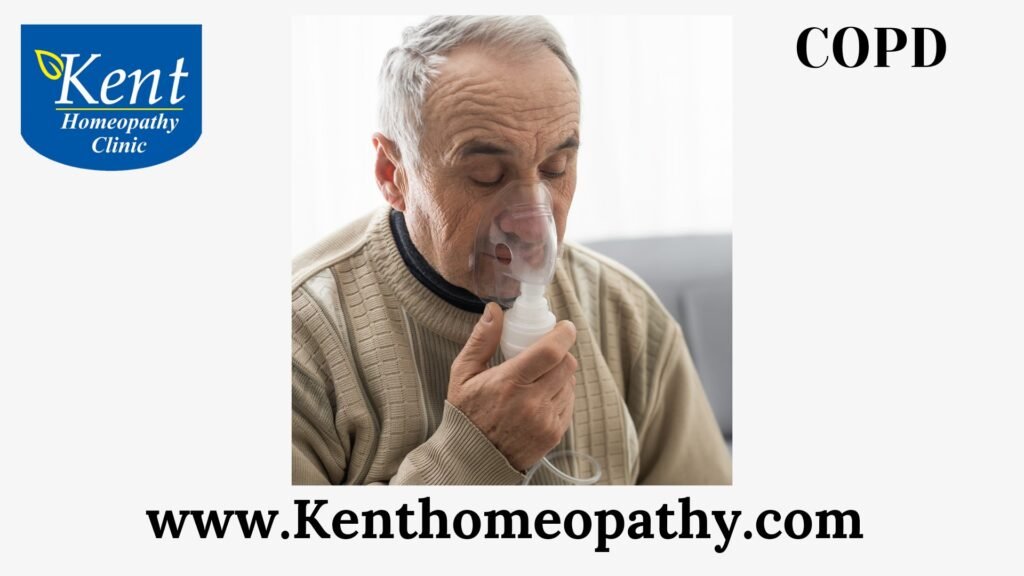
COPD
Chronic Obstructive Pulmonary Disease (COPD) is a progressive respiratory condition characterized by airflow limitation and difficulty breathing. It encompasses various lung diseases that obstruct airflow, primarily chronic bronchitis and emphysema. Understanding the symptoms, causes, and types of COPD is crucial for early detection and effective management.
Symptoms:
- Persistent Cough: A chronic cough that may produce mucus is a common symptom of COPD.
- Shortness of Breath: Individuals with COPD often experience a gradual onset of breathlessness, especially during physical activity.
- Wheezing: Wheezing or a whistling sound while breathing may occur due to narrowed airways.
- Chest Tightness: A sensation of tightness or pressure in the chest can be present.
- Frequent Respiratory Infections: COPD makes individuals more susceptible to respiratory infections like bronchitis or pneumonia.
- Fatigue: Reduced lung function can lead to fatigue and a decreased ability to perform physical activities.
Causes:
- Smoking: The primary cause of COPD is tobacco smoke, including both direct smoking and exposure to secondhand smoke.
- Environmental Exposures: Prolonged exposure to workplace pollutants, such as dust, chemicals, or fumes, can contribute to the development of COPD.
- Genetic Factors: A rare genetic disorder known as alpha-1 antitrypsin deficiency can increase the risk of developing COPD, even in nonsmokers.
- Indoor Air Pollution: Exposure to indoor pollutants like biomass fuels or poorly ventilated cooking areas can contribute to COPD.
- Age: While COPD typically develops later in life, long-term exposure to risk factors can accelerate its onset.
Types:
- Chronic Bronchitis: Characterized by chronic inflammation of the bronchial tubes, chronic bronchitis involves excessive mucus production, leading to persistent cough and airway obstruction.
- Emphysema: Emphysema primarily affects the air sacs (alveoli) in the lungs, causing them to lose elasticity. This results in the collapse of small airways and difficulty exhaling air.
- Chronic Obstructive Bronchitis: This term is often used to describe a combination of chronic bronchitis and emphysema, which frequently coexist in individuals with COPD.
Emphysema
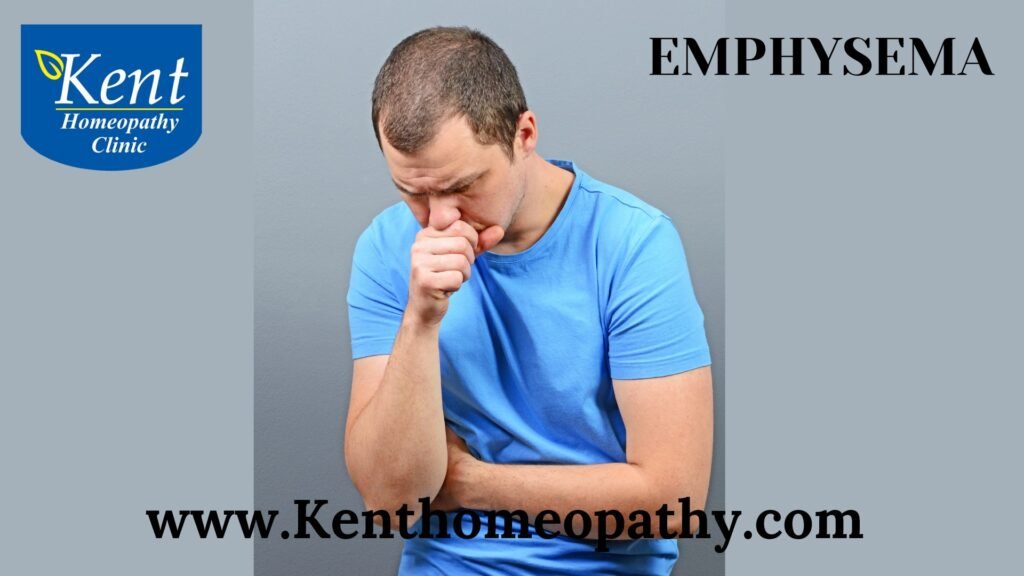
Emphysema
Emphysema is a chronic respiratory condition that falls under the umbrella term chronic obstructive pulmonary disease (COPD). It is characterized by the gradual damage to the air sacs (alveoli) in the lungs, leading to the impairment of respiratory function. Emphysema is often associated with long-term exposure to irritants, most commonly cigarette smoke.
Symptoms:
- Shortness of Breath: A progressive and persistent difficulty in breathing, especially during physical exertion.
- Chronic Cough: A persistent cough is common, and it may produce sputum.
- Wheezing: High-pitched whistling sounds during breathing, particularly during exhalation.
- Chest Tightness: A feeling of tightness or pressure in the chest.
- Fatigue: Reduced energy levels and increased tiredness due to the extra effort required for breathing.
Causes:
- Smoking: Cigarette smoke is the primary cause of emphysema. The harmful chemicals in tobacco smoke can lead to inflammation and damage to the lung tissue.
- Environmental Exposures: Long-term exposure to air pollutants, industrial dust, and fumes can contribute to the development of emphysema.
- Genetic Factors: A rare genetic condition known as alpha-1 antitrypsin deficiency can predispose individuals to emphysema. This condition results in a lack of a protective protein, allowing enzymes to damage lung tissue.
- Age: While emphysema can occur at any age, it is more common in older adults.
Types:
- Centriacinar (Centrilobular) Emphysema: This type predominantly affects the central or proximal parts of the acinus, the functional unit of the lung. It is commonly associated with cigarette smoking.
- Panacinar (Panlobular) Emphysema: In panacinar emphysema, the destruction of alveoli is uniform throughout the entire acinus. It is often linked to alpha-1 antitrypsin deficiency.
- Paraseptal Emphysema: This type is characterized by damage to the distal parts of the acinus, particularly near the lung pleura and interlobular septa. It may be seen in association with other types of emphysema.
While emphysema is a chronic and progressive condition, early diagnosis and appropriate management strategies can significantly improve the prognosis and enhance the quality of life for individuals living with this condition. Seeking medical advice and adhering to prescribed treatments are crucial for effective management.
Measles
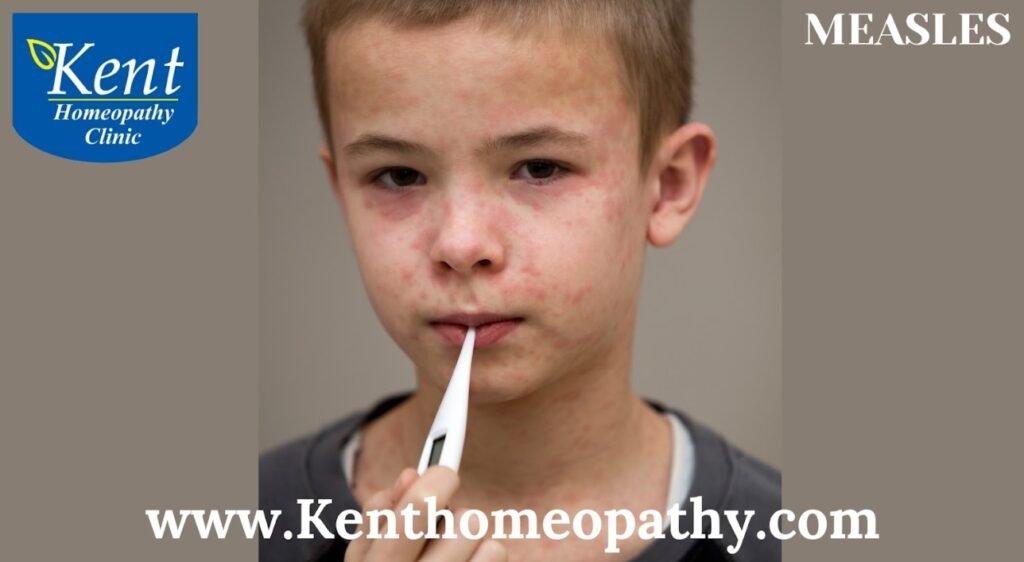
Measles
Measles: Understanding Symptoms, Causes, and Types
Measles, also known as rubeola, is a highly contagious viral infection caused by the measles virus (MeV). It primarily affects children but can occur at any age. Measles is preventable through vaccination, and widespread vaccination efforts have significantly reduced the global incidence of this disease. However, outbreaks can still occur in areas with low vaccination coverage.
Symptoms:
- High Fever:
– Measles typically begins with a high fever, often exceeding 101°F (38.3°C).
- Cough:
– A persistent cough is a common early symptom, usually accompanied by other respiratory symptoms.
- Runny Nose:
– A runny or stuffy nose is another early sign of measles.
- Red Eyes (Conjunctivitis):
– Inflammation of the eyes, leading to redness and sensitivity to light.
- Koplik’s Spots:
– Small white spots with bluish-white centers may appear inside the mouth, known as Koplik’s spots.
- Rash:
– A characteristic rash typically develops 3-5 days after the onset of symptoms. The rash starts as flat red spots and progresses to raised, reddish-brown blotches. It usually begins on the face and spreads down the body.
- Malaise:
– Generalized feelings of discomfort, malaise, and fatigue are common during measles infection.
- Complications:
– In severe cases, measles can lead to complications, including pneumonia, encephalitis (brain inflammation), and, rarely, death.
Causes:
- Measles Virus (MeV):
– Measles is caused by the measles virus, a paramyxovirus of the genus Morbillivirus. It is highly contagious and primarily spreads through respiratory droplets.
- Airborne Transmission:
– The virus is airborne and can remain infectious in the air and on surfaces for up to two hours after an infected person has left the area.
- Direct Contact:
– Measles can spread through direct contact with respiratory secretions or by touching surfaces contaminated with the virus and then touching the face.
- Infectious Period:
– A person with measles is contagious from 4 days before the rash appears to 4 days after. This makes it highly contagious, contributing to its rapid spread.
Types of Measles:
- Typical Measles (Classic or Hard Measles):
– The most common form of measles, characterized by the typical symptoms described above.
- Modified Measles:
– Occurs in individuals who have been partially immune due to previous vaccination or infection. Symptoms are often milder.
- Atypical Measles:
– A rare form that can occur in individuals who received an inactivated measles vaccine (killed vaccine) used in the United States before 1968. Symptoms may be more severe, and complications can include pneumonia and pleuritis.
Complications:
- Pneumonia:
– One of the most common complications, pneumonia can occur due to secondary bacterial infections.
- Encephalitis:
– Inflammation of the brain, which can lead to seizures, cognitive impairment, and, in severe cases, death.
- Ear Infections:
– Measles can cause ear infections, leading to hearing loss in some cases.
- Pregnancy Complications:
– Pregnant women with measles are at an increased risk of premature labor, low birth weight, and complications for the newborn.
Measles remains a significant global health concern, and efforts to increase vaccination coverage are crucial for preventing outbreaks and protecting vulnerable populations. Public health measures, early diagnosis, and supportive care contribute to reducing the impact of measles on affected individuals and communities.
Lung Infections
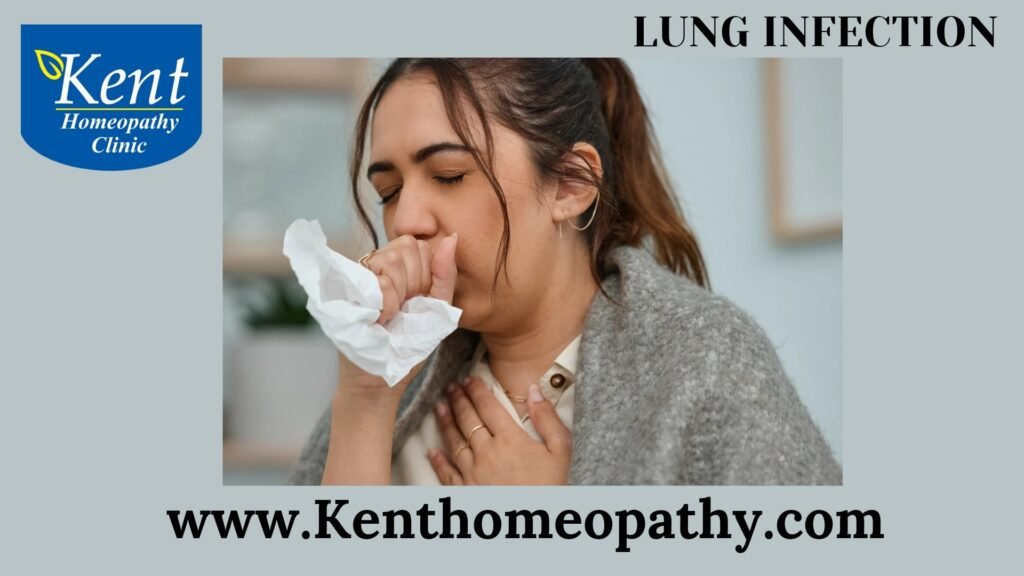
Lung Infections
Understanding Lung Infections: Symptoms, Causes, and Types:
Lung infections, also known as respiratory infections, are conditions that affect the respiratory system, specifically the lungs. These infections can involve various parts of the respiratory tract, from the airways to the lung tissue. They are caused by a variety of microorganisms, including bacteria, viruses, fungi, and parasites. Understanding the symptoms, causes, and types of lung infections is essential for accurate diagnosis and appropriate treatment.
Symptoms:
- Cough:
– A persistent cough is a common symptom of lung infections, often accompanied by sputum production.
- Shortness of Breath:
– Difficulty breathing or shortness of breath may occur, particularly during physical activity or exertion.
- Chest Pain:
– Chest pain or discomfort can result from inflammation in the lungs or the pleura (lining around the lungs).
- Fever:
– Elevated body temperature, fever, is a typical response to an infection as the body fights off invading microorganisms.
- Fatigue:
– Generalized weakness and fatigue are common symptoms, often associated with the body’s immune response.
- Wheezing:
– Wheezing, a high-pitched sound during breathing, may occur, indicating narrowed airways.
- Sputum Production:
– Changes in the color, consistency, or amount of sputum (phlegm) may be present, offering insights into the type of infection.
Causes:
- Viral Infections:
– Influenza (Flu): Influenza viruses can cause severe respiratory infections with symptoms like fever, cough, and body aches.
– Respiratory Syncytial Virus (RSV): Common in infants and older adults, RSV can lead to bronchiolitis and pneumonia.
- Bacterial Infections:
– Pneumonia: Bacterial pneumonia, often caused by Streptococcus pneumoniae, can result in inflammation and fluid accumulation in the air sacs of the lungs.
– Bronchitis: Bacterial bronchitis involves inflammation of the bronchial tubes and is commonly caused by bacteria such as Mycoplasma pneumoniae.
- Fungal Infections:
– Aspergillosis: Caused by Aspergillus fungi, this infection can affect the lungs, particularly in individuals with weakened immune systems.
– Pneumocystis Pneumonia (PCP): Common in individuals with compromised immune systems, PCP is caused by Pneumocystis jirovecii.
- Parasitic Infections:
– Paragonimiasis: Infection with lung flukes, such as Paragonimus species, can lead to respiratory symptoms and chest pain.
- Tuberculosis (TB):
– Mycobacterium tuberculosis: TB is a bacterial infection that primarily affects the lungs, causing persistent cough, weight loss, and chest pain.
Types of Lung Infections:
- Pneumonia:
– Inflammation of the air sacs in the lungs, commonly caused by bacteria, viruses, or fungi. Types include community-acquired pneumonia (CAP) and hospital-acquired pneumonia (HAP).
- Bronchitis:
– Inflammation of the bronchial tubes, leading to cough, increased mucus production, and difficulty breathing. Can be acute or chronic.
- Bronchiolitis:
– Common in infants, bronchiolitis involves inflammation of the small airways, causing wheezing and respiratory distress.
- Influenza (Flu):
– Viral infection causing fever, cough, sore throat, body aches, and fatigue.
- Tuberculosis (TB):
– Chronic bacterial infection, often affecting the lungs, with symptoms such as persistent cough, weight loss, and night sweats.
- Fungal Infections:
– Fungal lung infections, including aspergillosis and pneumocystis pneumonia, typically affect individuals with weakened immune systems.
- Lung Abscess:
– Collection of pus within the lung tissue, often caused by bacterial infections.
- Pleural Infections:
– Infections affecting the pleura, the lining around the lungs, leading to conditions like pleurisy or pleuritis.
Preventive measures, such as vaccination against influenza and pneumococcal pneumonia, proper hand hygiene, and avoiding exposure to tobacco smoke, contribute to reducing the risk of lung infections. Early recognition of symptoms and prompt medical attention are crucial for effective management and preventing complications associated with lung infections.
Respiratory Disease
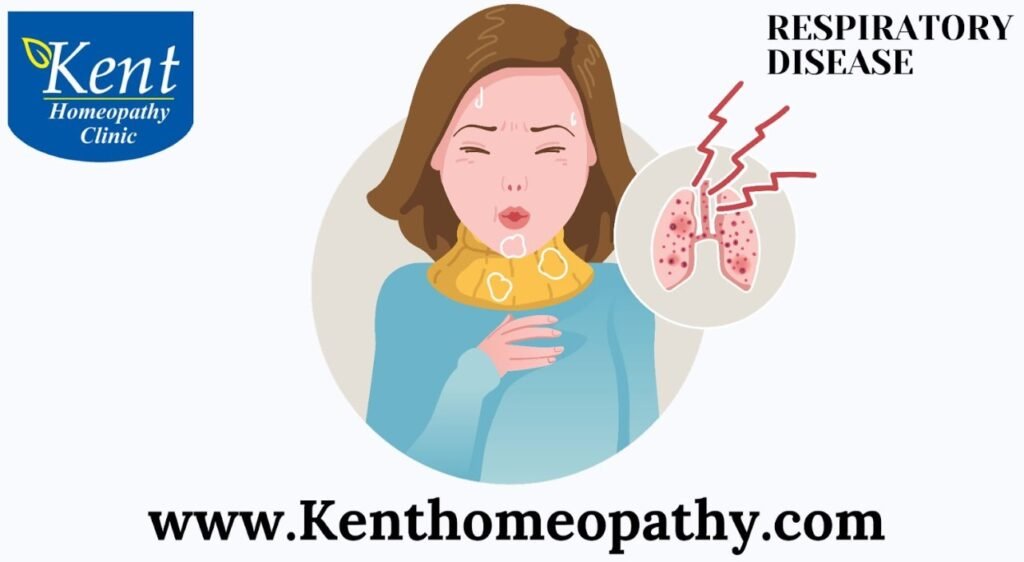
Respiratory Disease
Respiratory Disease: Unraveling Symptoms, Causes, and Types
Respiratory diseases encompass a broad range of conditions that affect the respiratory system, including the airways, lungs, and associated structures. These conditions can vary in severity, ranging from mild respiratory infections to chronic and potentially life-threatening diseases. Understanding the symptoms, causes, and types of respiratory diseases is essential for accurate diagnosis and effective management.
Symptoms:
- Cough:
– A persistent cough is a common symptom of many respiratory diseases. It can be dry or productive, producing mucus.
- Shortness of Breath:
– Difficulty breathing or shortness of breath may occur, especially during physical activity or exertion.
- Wheezing:
– Wheezing is a high-pitched whistling sound produced during breathing and is often associated with narrowed airways.
- Chest Pain or Tightness:
– Chest discomfort or a feeling of tightness may be present, especially in conditions like asthma or pneumonia.
- Fatigue:
– Chronic respiratory diseases can lead to fatigue and a general feeling of weakness.
- Fever:
– Respiratory infections often present with fever, which is the body’s response to an infection.
- Sputum Production:
– Some respiratory conditions involve the production of sputum, which can be clear, white, yellow, or greenish.
- Nasal Congestion:
– Nasal congestion or a runny nose is common in respiratory infections and conditions affecting the upper airways.
Causes:
- Infections:
– Respiratory infections, including viral and bacterial infections, are common causes of respiratory diseases. Examples include influenza, pneumonia, and bronchitis.
- Environmental Factors:
– Exposure to environmental pollutants, such as tobacco smoke, air pollution, and occupational hazards, can contribute to respiratory diseases.
- Allergies:
– Allergic reactions to airborne allergens like pollen, dust mites, or pet dander can lead to conditions like allergic rhinitis or asthma.
- Genetic Factors:
– Genetic predisposition can play a role in the development of certain respiratory conditions, such as cystic fibrosis or alpha-1 antitrypsin deficiency.
- Occupational Exposures:
– Exposure to certain substances in the workplace, such as asbestos, coal dust, or silica, can contribute to respiratory diseases like occupational lung disease.
- Autoimmune Conditions:
– Autoimmune diseases, including rheumatoid arthritis and systemic lupus erythematosus, may affect the respiratory system.
- Smoking:
– Tobacco smoking is a major risk factor for various respiratory diseases, including chronic obstructive pulmonary disease (COPD) and lung cancer.
Types:
- Asthma:
– Asthma is a chronic condition characterized by inflammation and narrowing of the airways, leading to recurrent episodes of wheezing, shortness of breath, and coughing.
- Chronic Obstructive Pulmonary Disease (COPD):
– COPD is a progressive lung disease that includes chronic bronchitis and emphysema. It is often associated with long-term exposure to irritants, primarily cigarette smoke.
- Pneumonia:
– Pneumonia is an infection of the lungs characterized by inflammation and the accumulation of fluid or pus in the air sacs. It can be caused by bacteria, viruses, or fungi.
- Influenza (Flu):
– Influenza is a viral infection that primarily affects the respiratory system. It can cause symptoms ranging from mild to severe and can lead to complications, especially in vulnerable populations.
- Tuberculosis (TB):
– Tuberculosis is a bacterial infection caused by Mycobacterium tuberculosis. It primarily affects the lungs but can also involve other organs. TB can be latent or active, with active TB presenting symptoms such as cough, weight loss, and night sweats.
- Interstitial Lung Disease:
– Interstitial lung diseases encompass a group of disorders characterized by inflammation and scarring of the lung tissue. Examples include idiopathic pulmonary fibrosis and sarcoidosis.
- Cystic Fibrosis:
– Cystic fibrosis is a genetic disorder that affects the respiratory and digestive systems. It leads to the production of thick and sticky mucus, affecting the lungs and causing respiratory infections.
- Lung Cancer:
– Lung cancer is characterized by the uncontrolled growth of cells in the lungs. It can present with symptoms such as persistent cough, chest pain, and shortness of breath.
- Pulmonary Embolism:
– Pulmonary embolism occurs when a blood clot travels to the lungs, causing a blockage in the pulmonary arteries. It can lead to symptoms like sudden shortness of breath and chest pain.
- Sleep Apnea:
– Sleep apnea is a sleep disorder where breathing repeatedly stops and starts during sleep. It can lead to daytime fatigue and an increased risk of cardiovascular problems.
Swine Flu

Swine Flu
Swine Flu (H1N1 Influenza): Unraveling Symptoms, Causes, and Types
Swine flu, also known as H1N1 influenza, is a respiratory infection caused by the H1N1 influenza A virus. It gained global attention in 2009 when it led to a pandemic. Understanding the symptoms, causes, and types of swine flu is crucial for timely diagnosis, appropriate management, and preventive measures.
Symptoms:
- Fever:
– High fever is a hallmark symptom of swine flu. Temperatures often exceed 100.4°F (38°C).
- Cough:
– A persistent cough, often accompanied by respiratory distress, is common in individuals with swine flu.
- Sore Throat:
– Swine flu can cause throat irritation and discomfort, leading to a sore throat.
- Body Aches:
– Muscular pain and body aches are frequent symptoms, contributing to an overall feeling of unwellness.
- Headache:
– Headaches of varying intensity can occur, ranging from mild to severe.
- Fatigue:
– Excessive tiredness and fatigue are common, impacting daily activities.
- Shortness of Breath:
– Respiratory symptoms may include shortness of breath or difficulty breathing, especially in severe cases.
- Nausea and Vomiting:
– Gastrointestinal symptoms like nausea and vomiting can accompany swine flu, particularly in children.
- Diarrhea:
– Some individuals with swine flu may experience diarrhea as part of the illness.
Causes:
- H1N1 Influenza Virus:
– Swine flu is caused by the H1N1 influenza A virus. This strain contains genetic elements from human, avian, and swine influenza viruses.
- Human-to-Human Transmission:
– Swine flu spreads through respiratory droplets when an infected person coughs or sneezes. It can also spread by touching surfaces contaminated with the virus and then touching the face.
- Close Contact with Infected Pigs:
– Direct contact with infected pigs or surfaces contaminated with their secretions can lead to transmission of the virus to humans.
- Community Outbreaks:
– Swine flu can lead to community outbreaks, particularly in crowded or enclosed spaces, such as schools, healthcare settings, or public transportation.
- Seasonal Variability:
– While swine flu can occur year-round, it often exhibits seasonal patterns, with increased cases during colder months.
Types:
- Seasonal H1N1 Influenza:
– This refers to the typical H1N1 strain that circulates as part of the seasonal flu. It is distinct from the 2009 H1N1 strain that caused the pandemic.
- Pandemic H1N1 Influenza (2009):
– The 2009 H1N1 influenza A virus, also known as swine flu, caused a global pandemic. It resulted from a reassortment of swine, avian, and human influenza viruses.
- Variant Influenza Viruses:
– Occasionally, new variant influenza viruses with H1N1 components may emerge in swine populations and pose a risk of transmission to humans.
Contact to know more
Contact
Timings
Monday to Saturday:
11:00 AM to 02:30 PM
06:30 PM to 09:00 PM
